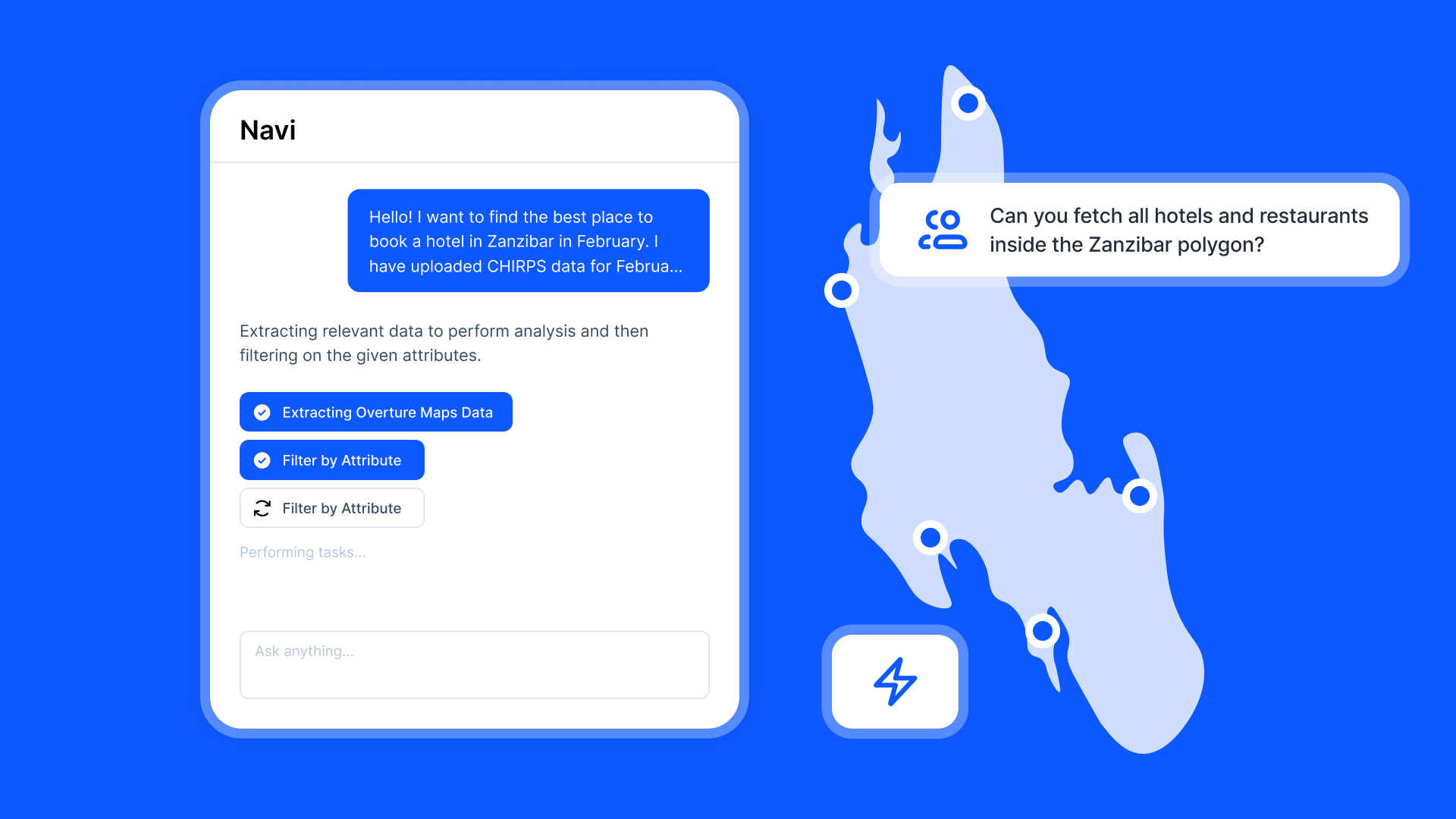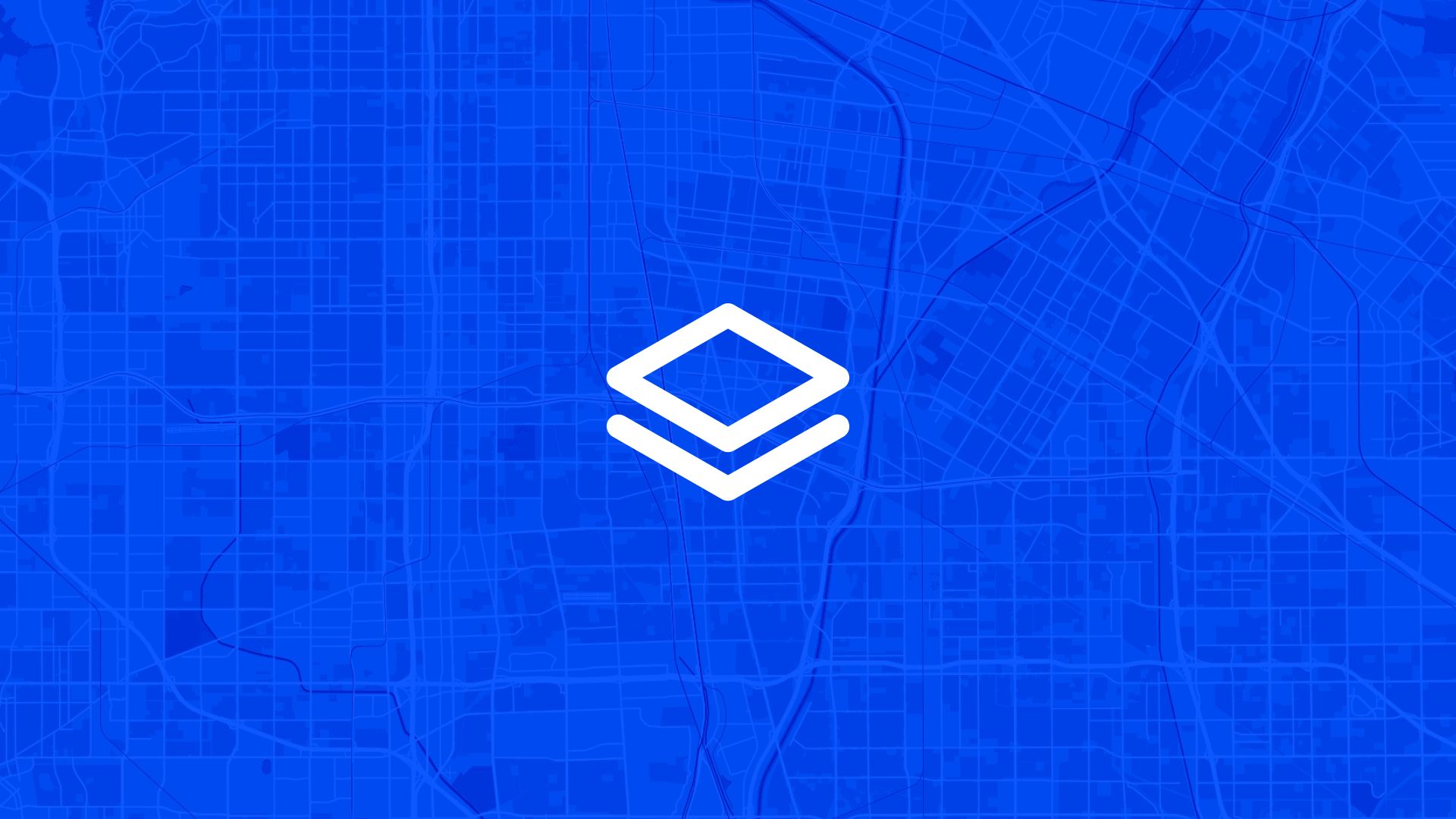The emergence of AI copilots for GIS represents a fundamental shift in how geospatial professionals work, enabling natural language interaction with spatial data and automating complex analytical workflows that previously required extensive technical expertise.
If you're exploring AI assistants for geospatial work or looking to accelerate spatial analysis through conversational interfaces, understanding the landscape of available GIS copilots helps you choose solutions that match your workflow needs, technical environment, and use cases. That's why GIS professionals ask: what are the best GIS copilots available today, and how do they differ in capabilities, integration, and approach to AI-assisted spatial analysis?
From agentic AI assistants that build complete applications to copilots integrated with established GIS platforms, the ecosystem offers diverse approaches to making geospatial analysis more accessible and efficient. No single copilot fits every workflow, but understanding your options enables informed decisions about which AI assistance will create the most value for your geospatial work.
Here are the top 3 GIS copilots transforming spatial analysis today.
1. Navi - Agentic AI Assistant from Atlas
Navi takes a comprehensive approach to geospatial AI assistance, functioning as an agentic system that switches seamlessly between building applications, editing data, and performing spatial analysis through natural language conversation.
Beyond a Simple Copilot: An Agentic Geospatial Assistant
Unlike traditional copilots that assist with specific tasks, Navi operates as an autonomous agent that understands context, plans multi-step workflows, and executes complete geospatial projects from natural language descriptions.
Navi is designed for the 99% who can't use traditional GIS software, eliminating the barrier between spatial thinking and technical implementation. When AI can build applications reliably enough for production use, organizations create exponentially more spatial tools—but only if those tools meet business-grade reliability standards.
Building Production-Ready Spatial Applications
Navi enables users to describe geospatial applications in plain English and automatically builds complete, operational tools:

Navi understands natural language descriptions and builds complete geospatial applications with data structures, visualizations, and workflows automatically.
Example conversation:
User: "Create an app for managing city tree inspections. Show a summary dashboard with tree health. Make it mobile-friendly, since teams will use it in the field."
Navi:
- Interprets requirements and spatial context
- Designs data structures for inspection records with location attributes
- Creates map visualizations showing tree locations
- Builds dashboard interfaces with health status summaries
- Configures mobile-responsive layouts for field use
- Produces a complete, production-ready application
This makes custom geospatial application development accessible to domain experts who understand their needs but lack GIS or programming expertise.
Multi-Modal Geospatial Intelligence
Navi provides comprehensive spatial capabilities beyond app generation:
Data management - Editing spatial datasets, cleaning location data, geocoding addresses, and managing geographic information through conversational commands.
Spatial analysis - Performing buffer analysis, spatial joins, proximity calculations, overlay operations, and complex geospatial workflows without technical GIS vocabulary.
Pattern discovery - Analyzing spatial data to find insights, identify clusters, detect anomalies, and answer questions like "what patterns exist in our service area performance?"
Workflow orchestration - Chaining multiple AI operations with human decision points to create complete, automated spatial intelligence systems.
Scaling Geospatial AI for Operations
What distinguishes Navi from traditional copilots is the ability to orchestrate and automate AI work as part of ongoing business operations:

Navi orchestrates complex spatial workflows, automating multi-step analysis and scaling AI operations across thousands of features.
Enterprise use case: Analyze every parcel in a list of 10,000 properties using consistent analytical criteria. As new parcels are added to the database, automatically trigger AI analysis as part of an existing workflow.
This requires more than conversational assistance—it needs applications that orchestrate, automate, and scale AI work as business operations. Navi provides:
- Workflow builders combining AI steps with human review and decision points
- Automation triggers based on data changes, schedules, or business events
- Scalable processing handling thousands of spatial features with consistent analysis
- Integration capabilities connecting with existing business systems and databases
- Production reliability suitable for operational use, not just experimentation
Enterprise-Grade Spatial Infrastructure
Navi builds on Atlas's proven geospatial platform:
Collaborative - Multiple team members work together on spatial data and applications with managed permissions, version control, and access management.
Scalable - Handles enterprise-scale spatial datasets and processing workloads without performance degradation as data volumes grow.
Visual - Users see what's happening with their data and logic through transparent workflows, not black box AI operations.
Secure - Enterprise-grade security, compliance, and reliability for business-critical geospatial applications and sensitive location data.
Production-ready - Spatial components are tested, reliable, and suitable for operational use in business environments.
This combination of AI-driven accessibility with enterprise infrastructure makes Navi suitable for organizations needing production-ready geospatial capabilities, not just analytical assistance.
Who Navi Serves
Navi addresses the needs of organizations and individuals facing barriers with traditional GIS:
- Business analysts building location intelligence dashboards and spatial analysis tools without GIS software expertise
- Operations teams creating field data collection applications and workflow automation without developer resources
- Planners conducting spatial analysis and scenario modeling through conversation rather than technical commands
- Domain experts leveraging spatial data to solve problems in their field without becoming GIS specialists
- Enterprises needing scalable, reliable geospatial applications built quickly and deployed securely
Learn more: Navi by Atlas
2. ArcGIS Copilot - Assisting GIS Analysis with LLM
ArcGIS Copilot integrates AI assistance into Esri's established ArcGIS ecosystem, providing natural language support for users working within ArcGIS Pro and ArcGIS Online environments.
Key Capabilities
Natural language queries - Asking spatial questions in plain English and receiving guided assistance in executing appropriate ArcGIS operations.
Workflow guidance - Getting step-by-step instructions for completing common GIS tasks and spatial analysis procedures within ArcGIS interfaces.
Tool discovery - Finding appropriate ArcGIS tools and functions through conversational descriptions of what you're trying to accomplish.
Documentation assistance - Accessing relevant help documentation and tutorials based on natural language questions about ArcGIS capabilities.
Microsoft 365 integration - Through the ArcGIS for Teams Copilot plugin, bringing spatial capabilities into Microsoft collaboration environments.
Integration Approach
ArcGIS Copilot focuses on making the extensive ArcGIS platform more accessible by providing conversational guidance for existing tools and workflows. It helps users navigate the rich feature set of ArcGIS software without memorizing all available functions and procedures.
The Microsoft 365 integration enables teams working in familiar collaboration tools to access spatial capabilities without switching to dedicated GIS applications, democratizing access to location intelligence.
Best For
ArcGIS Copilot serves organizations already invested in the Esri ecosystem who want to:
- Make ArcGIS more accessible to occasional users
- Reduce training time for new GIS users
- Enable spatial collaboration within Microsoft 365 workflows
- Help users discover relevant ArcGIS capabilities for their tasks
The copilot complements rather than replaces ArcGIS expertise, providing assistance within the established Esri framework.
Learn more: ArcGIS Copilot
3. AutonomousGIS - QGIS Spatial Analysis Agent
AutonomousGIS brings AI assistance to the open-source QGIS platform through a plugin that enables natural language spatial analysis and automated workflow execution.
Key Capabilities
Natural language processing - Describing spatial analysis tasks in plain English and having the plugin translate them into QGIS operations.
Automated workflow execution - The agent automatically executes multi-step spatial analysis procedures based on natural language requests.
QGIS tool integration - Leveraging QGIS's extensive processing toolbox and spatial analysis capabilities through conversational interfaces.
Open-source approach - Built as a QGIS plugin, it integrates with the broader open-source geospatial ecosystem and can be extended by the community.
Python integration - Working with QGIS's Python API to automate spatial analysis and data processing workflows.
Plugin Architecture
As a QGIS plugin, AutonomousGIS extends the capabilities of the popular open-source GIS platform without requiring users to switch tools or platforms. It maintains compatibility with QGIS's extensive plugin ecosystem and processing algorithms.
The plugin approach allows the open-source community to contribute improvements, add features, and adapt the agent to specific domain needs and workflows.
Best For
AutonomousGIS serves organizations and individuals who:
- Use QGIS as their primary GIS platform
- Want open-source AI assistance for spatial analysis
- Need automated workflow execution within QGIS
- Value community-driven development and extensibility
- Prefer avoiding proprietary commercial platforms
The plugin makes QGIS more accessible to non-specialists while providing automation capabilities for experienced users.
Learn more: AutonomousGIS Plugin
Comparing GIS Copilot Approaches
The three GIS copilots take different approaches to AI-assisted geospatial work:
Scope and Autonomy
Navi (Agentic System) - Functions autonomously to build applications, edit data, and perform analysis. Plans and executes complete projects from high-level requests.
ArcGIS Copilot (Guided Assistant) - Provides guidance and assistance for using ArcGIS tools. Helps users navigate existing functionality rather than operating autonomously.
AutonomousGIS (Analysis Agent) - Automates spatial analysis workflows within QGIS. Translates natural language to QGIS operations and executes them.
Platform Integration
Navi - Standalone platform with Atlas infrastructure, not requiring existing GIS software. Cloud-based with full application development capabilities.
ArcGIS Copilot - Deeply integrated with Esri ecosystem. Requires ArcGIS licenses and works within existing ArcGIS environments.
AutonomousGIS - QGIS plugin installation. Works within open-source QGIS platform and requires QGIS installation and configuration.
Application Building vs. Analysis Assistance
Navi - Builds complete applications, not just performing analysis. Creates production-ready tools with data structures, interfaces, and workflows.
ArcGIS Copilot - Assists with using existing applications and tools. Helps users accomplish tasks within ArcGIS software.
AutonomousGIS - Automates spatial analysis workflows. Executes QGIS operations based on natural language descriptions.
Enterprise Readiness
Navi - Built for production use with enterprise security, scalability, and reliability. Designed for business-critical applications and large-scale operations.
ArcGIS Copilot - Leverages Esri's enterprise-grade infrastructure. Benefits from ArcGIS's established security and scalability capabilities.
AutonomousGIS - Open-source plugin with community support. Enterprise deployment depends on organization's QGIS infrastructure and support model.
Target Users
Navi - Non-GIS specialists needing spatial capabilities. Domain experts building custom applications without technical skills.
ArcGIS Copilot - Existing ArcGIS users wanting easier access to capabilities. Organizations with Esri investments seeking to democratize GIS use.
AutonomousGIS - QGIS users wanting automated workflows. Open-source advocates and organizations building on QGIS platforms.
Choosing the Right GIS Copilot
Selecting a GIS copilot depends on several factors:
Existing Technology Stack
Esri environment - Organizations with ArcGIS investments benefit from ArcGIS Copilot's deep integration with existing tools and workflows.
Open-source stack - QGIS users and open-source advocates fit naturally with AutonomousGIS's plugin architecture and community approach.
No existing GIS - Organizations without established GIS infrastructure benefit from Navi's standalone platform requiring no prerequisite software.
Use Case Requirements
Application development - Building custom spatial applications requires Navi's app generation and workflow orchestration capabilities.
Analysis assistance - Users needing help with spatial analysis tasks benefit from any of the three copilots, with choice depending on platform preference.
Workflow automation - Automating repetitive spatial operations works with Navi or AutonomousGIS, depending on infrastructure needs.
Collaboration - Teams working in Microsoft 365 benefit from ArcGIS Copilot's integration with collaboration tools.
Technical Capacity
Low technical barrier - Navi requires no GIS expertise, making it accessible to domain experts and business users.
GIS proficiency - ArcGIS Copilot and AutonomousGIS assist GIS users but assume familiarity with spatial analysis concepts and workflows.
IT infrastructure - Cloud-based Navi eliminates infrastructure management. ArcGIS and QGIS copilots require corresponding platform installations.
Scale and Operations
Enterprise operations - Production-scale applications benefit from Navi's enterprise infrastructure and reliability focus.
Individual analysis - Single users performing spatial analysis work effectively with any copilot matching their platform preference.
Team collaboration - Multi-user environments benefit from cloud-based platforms (Navi, ArcGIS Online) versus desktop tools.
The Future of GIS Copilots
Several trends are shaping GIS copilot evolution:
Increased autonomy - Moving from guidance and assistance toward truly autonomous agents that plan and execute complete spatial projects.
Multi-modal capabilities - Understanding text, imagery, and spatial data together for comprehensive geospatial intelligence assistance.
Workflow orchestration - Chaining AI operations with human input for complex spatial intelligence systems rather than isolated analysis tasks.
Cross-platform integration - Better interoperability between different GIS environments and business systems for seamless spatial workflows.
Domain specialization - Copilots customized for specific industries and applications with understanding of domain-specific terminology and workflows.
Real-time collaboration - Multiple users and AI agents working together on shared spatial projects with maintained context and coordination.
Getting Started with GIS Copilots
To begin leveraging AI assistance for geospatial work:
- Assess current tools - Evaluate whether you have existing GIS software investments or need standalone solutions
- Define use cases - Identify specific workflows where AI assistance creates the most value for your team
- Consider expertise - Match copilot capabilities with your team's current GIS proficiency and learning capacity
- Test with pilots - Try copilots on small projects before committing to large-scale adoption
- Plan for integration - Consider how AI assistance fits into broader workflows, systems, and business processes
Use Cases
The top GIS copilots serve different organizational needs:
- Organizations without GIS expertise needing custom spatial applications benefit from Navi's conversational app building and autonomous operation
- Esri customers wanting to democratize ArcGIS access leverage ArcGIS Copilot's integration with existing investments
- Open-source GIS users seeking workflow automation benefit from AutonomousGIS's QGIS plugin architecture
- Enterprises requiring production-scale spatial applications rely on Navi's enterprise infrastructure and reliability
- Teams collaborating in Microsoft 365 use ArcGIS Copilot's integration for spatial intelligence in familiar tools
It's about matching copilot capabilities to your technology environment, use cases, and organizational needs.
Tips
- Start with clear requests providing specific geographic context and desired outcomes to get better AI assistance
- Verify AI outputs checking that copilot interpretations match your intent, especially for important analysis
- Leverage strengths using copilots for exploration and rapid prototyping while maintaining manual control for critical production work
- Provide feedback helping AI assistants learn your terminology, preferences, and workflows over time
- Consider total cost evaluating not just licensing but training, integration, and operational expenses for different copilot options
Understanding the top GIS copilots enables informed decisions about which AI assistance will create the most value for your geospatial workflows and organizational needs.
No single copilot fits every situation. Choose based on your existing tools, use cases, technical capacity, and whether you need guidance, automation, or complete application development capabilities.





